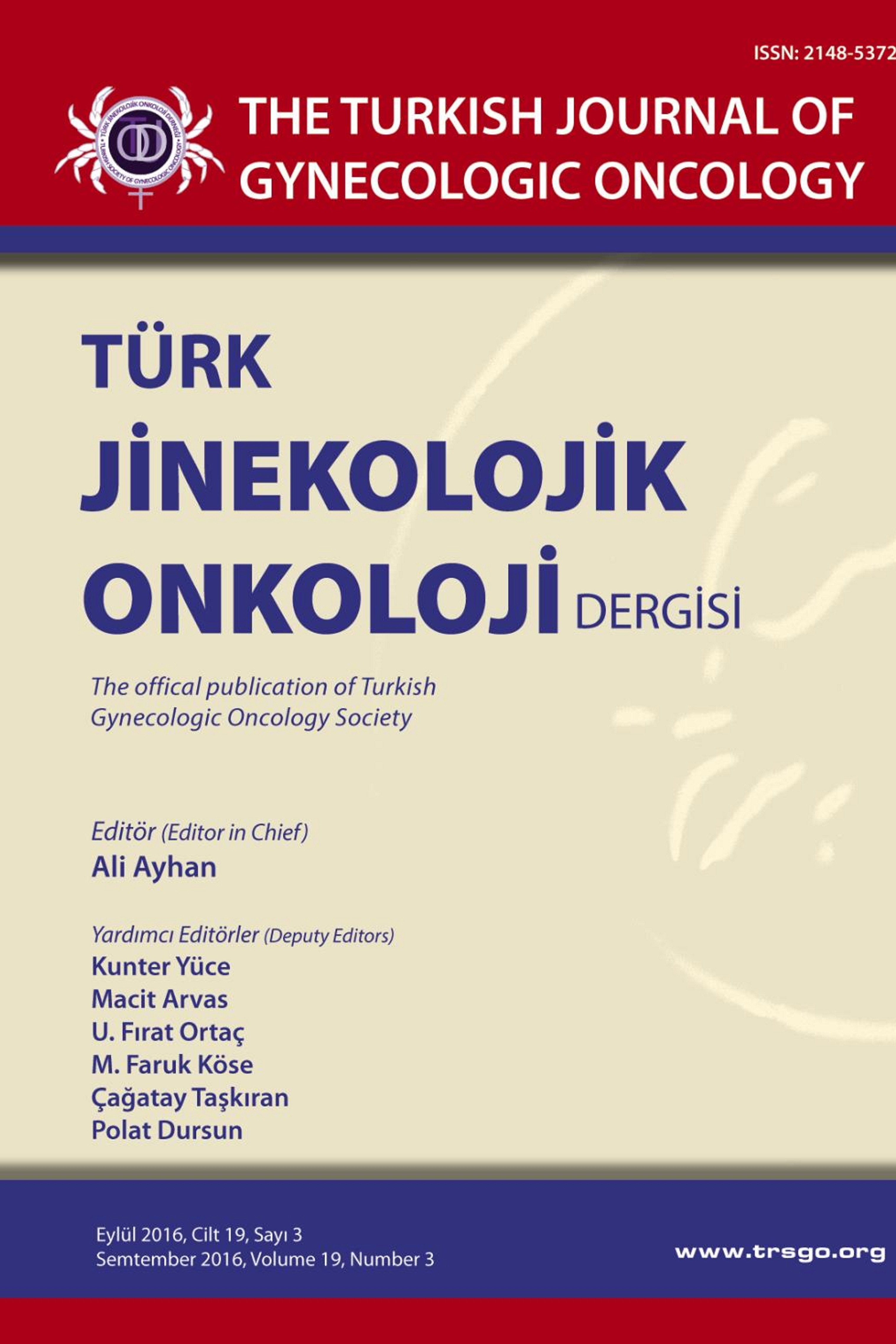İLERİ EVRE YÜKSEK GRADE ENDOMETRİUM KANSERLİ HASTALARDA SAĞKALIM SONUÇLARI
seröz, berrak hücreli, karsinosarkom, mikst, grade 3 endometrioid ve undiferansiye
SURVIVAL RESULTS OF PATIENTS WITH HIGH-GRADE AND ADVANCED-STAGE ENDOMETRIAL CANCER
serous, clear cell, carcinosarcoma, mixed, grade 3 endometrioid and undifferentiated,
___
- 1. Gottwald L, Pluta P, Piekarski J, Spych M, Hendzel K, Topczewska-Tylinska K, et al. Long-term survival of endometrioid endometrial cancer patients. Arch Med Sci. 2010;6(6):937–44.
- 2. Reynaers EAEM, Ezendam NPM, Pijnenborg JMA. Comparable outcome between endometrioid and nonendometrioid tumors in patients with early-stage highgrade endometrial cancer. J Surg Oncol. 2015;111(6):790– 4.
- 3. Oliva E, Soslow RA. High-Grade Endometrial Carcinomas. Vol. 4, Surgical Pathology Clinics. 2011. p. 199–241.
- 4. Soslow RA. High-grade endometrial carcinomas - strategies for typing. Vol. 62, Histopathology. 2013. p. 89–110.
- 5. Amant F, Moerman P, Neven P, Timmerman D, Van Limbergen E, Vergote I. Endometrial cancer. Lancet (London, England). 2005;366(9484):491–505.
- 6. Sorosky JI. Endometrial cancer. Obstet Gynecol. 2012;120(2 Pt 1):383–97.
- 7. Morice P, Leary A, Creutzberg C, Abu-Rustum N, Darai E. Endometrial cancer. In: The Lancet. 2016. p. 1094–108.
- 8. Lee NK. Adjuvant treatment of advanced-stage endometrial cancer. Clin Obstet Gynecol. 2011;54(2):256–65.
- 9. Tangjitgamol S, See HT, Kavanagh J. Adjuvant chemotherapy for endometrial cancer. Int J Gynecol Cancer. 2011;21(5):885–95.
- 10. Cantrell LA, Blank S V., Duska LR. Uterine carcinosarcoma: A review of the literature. Vol. 137, Gynecologic Oncology. 2015. p. 581–8.
- 11. Ferguson SE, Tornos C, Hummer A, Barakat RR, Soslow RA. Prognostic features of surgical stage I uterine carcinosarcoma. Am J Surg Pathol. 2007;31(11):1653–61.
- 12. Gokce ZK, Turan T, Karalok A, Tasci T, Ureyen I, Ozkaya E, et al. Clinical outcomes of uterine carcinosarcoma: results of 94 patients. Int J Gynecol Cancer. 2015;25(2):279– 87.
- 13. Vaidya AP, Horowitz NS, Oliva E, Halpern EF, Duska LR. Uterine malignant mixed mullerian tumors should not be included in studies of endometrial carcinoma. Gynecol Oncol. 2006;103(2):684–7.
- 14. Roelofsen T, van Ham MAPC, Wiersma van Tilburg JM, Zomer SF, Bol M, Massuger LFAG, et al. Pure Compared With Mixed Serous Endometrial Carcinoma. Obstet Gynecol. 2012;120(6):1371–81.
- 15. Espinosa I, D’Angelo E, Palacios J, Prat J. Mixed and ambiguous endometrial carcinomas. Am J Surg Pathol. 2016;40(7):972–81.
- 16. Moore KN, Fader AN. Uterine papillary serous carcinoma. Clin Obstet Gynecol. 2011;54(2):278–91.
- 17. Ayeni TA, Bakkum-Gamez JN, Mariani A, McGree ME, Weaver AL, Haddock MG, et al. Comparative outcomes assessment of uterine grade 3 endometrioid, serous, and clear cell carcinomas. Gynecol Oncol. 2013;129(3):478– 85.
- 18. Felix AS, Stone RA, Bowser R, Chivukula M, Edwards RP, Weissfeld JL, et al. Comparison of survival outcomes between patients with malignant mixed mullerian tumors and high-grade endometrioid, clear cell, and papillary serous endometrial cancers. Int J Gynecol Cancer. 2011;21(5):877–84.
- 19. Hamilton C, Cheung M, Osann K, Chen L, Teng N, Longacre T, et al. Uterine papillary serous and clear cell carcinomas predict for poorer survival compared to grade 3 endometrioid corpus cancers. Br J Cancer. 2006;94(5):642–6.
- 20. Greggi S, Mangili G, Scaffa C, Scala F, Losito S, Iodice F, et al. Uterine papillary serous, clear cell, and poorly differentiated endometrioid carcinomas: a comparative study. Int J Gynecol Cancer. 2011;21(4):661–7.
- 21. Alkushi A, Köbel M, Kalloger SE, Gilks CB. High-Grade Endometrial Carcinoma: Serous and Grade 3 Endometrioid Carcinomas Have Different Immunophenotypes and Outcomes. Int J Gynecol Pathol. 2010;29(4):343–50.
- ISSN: 2148-5372
- Başlangıç: 2014
- Yayıncı: Türk Jinekolojik Onkoloji Derneği
İLERİ EVRE YÜKSEK GRADE ENDOMETRİUM KANSERLİ HASTALARDA SAĞKALIM SONUÇLARI
Alpaslan KABAN, Samet TOPUZ, Hamdullah SÖZEN, Yavuz SALİHOGLU
HUMAN PAPİLLOMAVİRUS GENOTİPLERİNİN PYROSEQUENCİNG METODU İLE TESPİTİ
Serap ÖZEN, Mehmet ÇİMENTEPE, Buket ŞEFLEK, Mehmet Ali VARDAR, Derya GÜMÜRDÜLÜ, Fügen YARKIN
SERVİKS KANSERİ YA DA SERVİKAL İNTRAEPİTHELİAL NEOPLAZİ SAPTANAN HASTALARIN HPV TEST SONUÇLARI
Fatma SERT, Senem ALANYALI, Arif Bülent ARAS, Zeynep ÖZSARAN
GESTASYONEL TROFOBLASTİK HASTALIKLARA GÜNCEL YAKLAŞIM CONTEMPORARY
Kemal GÜNGÖRDÜK, Ceysu KOCAHAKİMOĞLU, Muzaffer SANCI, Özalp Sabit SİNAN, Varol GÜLSEREN, Dilek KARTAL
